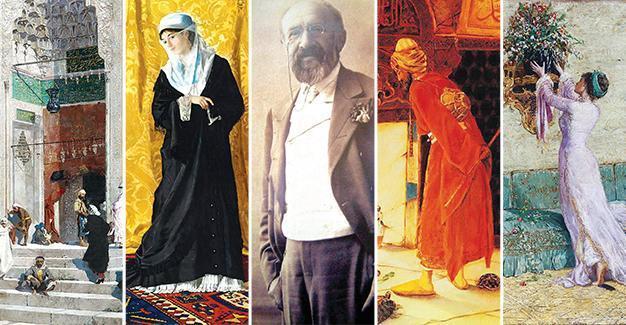Ottoman-era artist’s work to break records at auction
ISTANBUL – Anadolu Agency
 A masterpiece by the late-Ottoman artist Osman Hamdi Bey looks set to go for a record price at an upcoming spring sale, according to a local auction house.
A masterpiece by the late-Ottoman artist Osman Hamdi Bey looks set to go for a record price at an upcoming spring sale, according to a local auction house.Antik A.Ş., one of the leading auction houses in Turkey, announced that the oil canvas piece “Cami Önü” (the front of the mosque) has a starting price of 10 million Turkish Liras.
Having played a pioneering role in the maturation of Western art in the Ottoman Empire, Osman Hamdi Bey (1842-1910) was not only known for his paintings but also his contribution to the fields of archaeology and museology.
Edhem Eldem, a history professor at New York’s Columbia University, said Osman Hamdi was a significant figure in Turkish culture.
“As one of the best documented and arguably ‘local’ artists for the period, Osman Hamdi naturally stands at the very top of this artistic hierarchy,” he said.
“The extraordinary prices fetched by Osman Hamdi’s paintings have to do with the specificities of the Turkish market for art,” Eldem added.
Eldem, who is also the grandson of Osman Hamdi’s niece Azize Hanım and writer of many books on the artist, said the Turkish art market was “recent and still underdeveloped and lags behind the international market but is trying to set up its own standards.”
“With very little artwork available for the 19th century, practically anything painted in or about the Ottoman Empire will acquire an inflated value,” the professor said.
He also pointed out the socio-economic side of the issue, where a burgeoning Turkish middle class fuels the desire for expensive fine art, “in the shape of a moneyed bourgeoisie that has developed since the liberal turn of the 1980s and wants to acquire art as a form of investment and conspicuous consumption.”
‘Moving composition’
The Istanbul-based auction house’s board chairman, Turgay Artam, said “Cami Önü” was one of the most important pieces in Turkish painting. “With its fine details, Ottoman figures all carefully calculated and placed, its moving composition; [the painting] takes viewers to 1800s Ottoman experience,” Artam said.
The 134-year-old painting depicts 16 Ottoman characters including men, veiled women and merchants as well as beggars in front of Turkey’s famous Green Mosque in the northwestern city of Bursa, the empire’s first capital.
According to Eldem, the importance of the painting lies in its theme: “It is one of the first examples of a theme that he will exploit and develop for another 10 or 15 years.”
One of the largest known oil-canvas works by Osman Hamdi, the painting is likely to fetch a very high price “for the simple reason that there are practically no Osman Hamdi paintings left on the market,” he said.
“There are constantly new fortunes being made in Turkey, which increases the likelihood of aggressive bids. To this we should add the growing number of private collections turned into private museums, [which] are even more likely to fight over this chance to have an Osman Hamdi,” he adds.
Although Eldem does not agree, some scholars view Osman Hamdi as a person torn between East and West and a victim of his period’s Westernization dilemma.
“His cultural and civilizational choices were clearly in the direction of the West, with a vision of the East that could range from curiosity to criticism and from aesthetic appreciation to rejection. That is what made him an Orientalist, even if he had a good dose of the 19th-century patriotism that set him apart from his Western contemporaries,” he said.
“Yet all of this was done with a great deal of self-assurance and, eventually, success, rather than victimization,” he said.
“As to the critical assessment of his work as tainted by Orientalist clichés and hesitations, it rests on too much retro-projection and hindsight based on our contemporary concerns,” he said.
Record-breaking artist
One of the famed paintings of Osman Hamdi, “The Tortoise Trainer,” which dates back to 1906, was sold for a record 5.5 million Turkish liras in 2004 by Antik A.Ş. and it is now part of Istanbul’s Pera Museum’s collection.
Another painting “Istanbul Hanımefendisi” (The Lady of Constantinople) was sold for $6.5 million at a Sotheby’s auction in London, another record for the artist, in 2008.
His “Vazo Yerleştiren Kız” (A Girl Arranging a Vase for Flowers) was sold by Antik A.Ş. for 3.2 million Turkish liras in 2012 while another London auction saw the sale of the artist’s “Kuran Okuyan Adam” (Man Reading the Quran) for 3 million pounds in the same year. More recently the Louvre Abu Dhabi museum bought his “A Young Emir Studying.”
For Eldem, Osman Hamdi, the very unique actor of modernity in Ottoman history, is remembered as an artist for the “sensational aspect of the prices his works have fetched recently.”
















